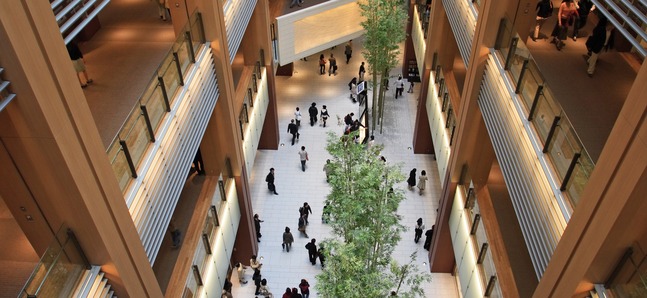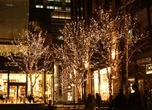
Posted: Mon Sep 28 2009
Tokyoites know how to shop, and they're getting better at it all the time. Above and beyond being an opportunity to buy rare crafts, manga or electronics, time spent shopping in Tokyo should be considered almost as an anthropological study.
Megaplexes rise up
A spate of large-scale, all-in-one consumer magnets in the Roppongi and Marunouchi districts has raised those areas' profiles and added several spending options to the city, including 2007’s Tokyo Midtown and the Shin Marunouchi building Monocle magazine honcho Tyler Brûlé described Midtown as ‘the new international benchmark for mixed-use developments', for its range of outlets and attention to detail. The interior is certainly impressive, using water and wood to create a remarkably serene atmosphere, and the tenants have clearly made the effort to keep up. Everything from the 7-11 convenience store to the basement food court blends seamlessly into the upmarket aesthetic. But behind the sleek designs, the retail experiences are more conventional. Other than the dark, disco-like super-boutique Restir, it's best to think of Midtown's shops as a diversion after visiting one of the eateries or the cultural attractions 21_21 Design Sight and the Suntory Museum of Art.
Similarly, in nearby Roppongi Hills, unless you're looking for mainstream women's fashion, the shopping is best seen as a complement to a trip around the Mori Art Museum. The Marunouchi area has undergone an equally dramatic makeover recently. The former business district has been revitalised by Mitsubishi Real Estate. The once-quiet Naka Dori is now a big, brand-lined boulevard that leads to the mixed-use Marunouchi Building, the first structure to flout a long-standing but unofficial rule preventing buildings from overlooking the Imperial Palace. A similar venture, the Shin Marunouchi Building, opened virtually next door in 2007 and while the former is notable only for its restaurants, the latter offers a fascinating insight into the conservative tastes of the working women resident in the Kanto region, with its combination of bland boutiques and minimalist patisseries. Tokyo's trendiest, most innovative fashion retailers still choose to be based in upscale Aoyama and the adjacent Harajuku district. A wander around the streets here will uncover any number of interesting stores, ranging from hip hop style source A Bathing Ape and cult newcomer Billionaire Boys Club to the spectacular high-end flagships of Comme des Garçons, Louis Vuitton and Prada. Directly opposite Comme des Garçons is the painfully trendy, dungeon-like fashion emporium Loveless, with a large selection of up-and-coming home-grown brands. Meanwhile, local teens are served at the recently revamped fashion mall Laforet, an earlier venture from the magnate behind Roppongi Hills. Serious antiques freaks are also served in Aoyama, where a stroll along nearby Kotto Dori will take you to half a dozen of the city's longest established dealerships.
Youth central
A one-stop ride from Harajuku Station is Shibuya, where fast-fashion mecca 109 is an essential destination, whether you're looking for the fashion of the week or simply watching those that are. Nearby manga and anime megastore Mandarake (B2F Beam Bldg, 31-2 Udagawacho, Shibuya-ku, 3477 0777, www.mandarake.co.jp) is the most central option for geek goods. More committed fans need to head to Akihabara, where the area known for its electronics is fast becoming a haven for otaku (geek) culture in all its forms, everything from homemade manga to multimillion yen sex dolls is on offer. And the electronics are still in plentiful supply, with several multi-storey emporiums competing for your attention here. 2008 saw the re-imaging of Akihabara as a commuter hub, and the opening of Akiba Tolim, a shopping complex created with the female office-worker in mind. Shoppers can find cafés, restaurants and sweet shops among the boutiques and Akihabara standard-issue hobby shop.
Across town, in Nakano on the Chuo line, sits the other great home of all things anime: the Nakano Broadway shopping centre (3387 1610, www.nbw.jp). This shabby, time-worn arcade is home to several branches of Mandarake and Fujiya Avic, where you can pick up classic manga, collectable figures and bootlegs of the geek variety.
Spend, spend, spend!
Tokyo's most famous consumer destination is Ginza, a name so widely known as a synonym for luxurious consumer experiences that small towns across the nation have named their shopping streets after it. Premium department stores and European luxury brands dominate the landscape. The important foreign fashion behemoths are all represented, satisfying the never-diminishing local appetite for brand-emblazoned bags, but the best reason to check them out is their dramatic facades. Mikimoto, Chanel and Maison Hermès all have photo-worthy stores that play up to Tokyo's taste for whimsy. The back streets of Ginza are worth exploring, with dozens of interesting little shops purveying traditional crafts, kimono, samurai swords and the like. One must here is Japanese paper specialist Kyukyodo, whose Ginza store, with its landmark arched brick entrance, proffers seasonal gift cards and lots of small and moderately priced items (boxes, notebooks, picture frames) made from colourful washi. Foodies should head for the basements of the department stores, known as depachika, where vast arrays of gourmet delights offer visual and olfactory stimulation. The nation's leading confectioners are all here, vying to assist you in your souvenir search. Try wasanbon, a delicately flavoured powdered sugar tablet, or azuki bean yokan cakes. You'll also find an extensive selection of green tea, exquisitely wrapped.
Akasaka is an upscale area akin to Ginza that has seen development take place rather recently. This area is noted for its swanky dining options, but now also hosts a worthy location for shopping in akasaka Sacas. The complex opened in 2008 and is comprised of boutiques, restaurants, cafés, theatres and galleries in addition to luxury residential quarters and the TBS Broadcasting Centre.
Turntable treats
In Tokyo, vinyl is alive and kicking. Shibuya is renowned for its devotion to wax, catering largely to the house and hip hop crowds with new and vintage discs. Shinjuku is the place to look for rock and alternative, with scores of tiny shops clustered around Otakibashi Dori, the main road that heads north from Shinjuku Station’s west exit. Shinjuku is also the main home of domestic chain Disk Union, each of whose numerous branches specialises in a particular genre, whether you’re into punk, funk, jazz or heavy metal. In both Shibuya and Shinjuku, many of the specialist stores are tucked away in apartment buildings, with street-side sandwich boards alerting you to their existence. These diminutive outlets are usually pricier than other shops, but the owners are die-hard fans who source global vinyl, so the selection tends to be first-rate.
Hours
Opening times are inching ever longer. The standard is still 10am or 11am until 8pm daily, but many shops in the busiest areas, such as Shibuya, Harajuku or Shinjuku, now stay open as late as 10pm. Independent shops, especially the traditional or craft-oriented ones, may close for one day, usually Monday or Wednesday. Most shops stay open on national holidays, but it's wise to call ahead to check.
Time Out Tokyo Shortlist (Published in 2007)
Tweets
- About Us |
- Work for Time Out |
- Send us info |
- Advertising |
- Mobile edition |
- Terms & Conditions |
- Privacy policy |
- Contact Us
Copyright © 2014 Time Out Tokyo











Add your comment